- Publisher's Note
- Editorial
- Love of Life (that) Spills Over
- A Continuing Multiplication
- From Painting to Print
- Intimate Involvement
- Portrait of the Artist as an Old Man
- (Hi)Story of the Garhi Printmaking Studios, New Delhi
- Surinder Chadda
- Ramendranath Chakravorty
- Group 8
- Mother and Child: A Screenplay
- Straddling Worlds
- A Brief History of Printmaking at Santiniketan
- Vignettes from History
- Southern Strategies
- The Forgotten Pioneer: Rasiklal Parikh
- Printmaking in the City Of Joy
- Amitabha Banerjee: His Art and Aesthetic Journey
- Local Style and Homogenizing trends: Early Medieval Sculpture in Galaganatha
- English China: Delicate Pallid Beauty
- The Beauty of 'Bilal'
- Photo Essay
- The Way of The Masters: The Great Artists of India 1100 –1900
- Striving Towards Objectivity
- The Art of Sculpting In the Contemporary Times
- An Artistic Framework for an Alternative to Ecology
- Bidriware and Damascene Work in Jagdish and Kamla Mittal Museum of Indian Art
- A Lowdown on the Print Market
- The 'bubble' and the 'wobble'
- What Happened and What's Forthcoming
- Art Bengaluru
- Art Events Kolkata: June – July 2011
- Musings from Chennai
- Mumbai Art Sighting
- Previews
- In the News
- Christie's Jewellery Auction at London, South Kensington
ART news & views
Southern Strategies
Volume: 3 Issue No: 19 Month: 8 Year: 2011
An overview of the region's contributions as the practice of printmaking in southern India becomes more dynamic
by Lina Vincent Sunish
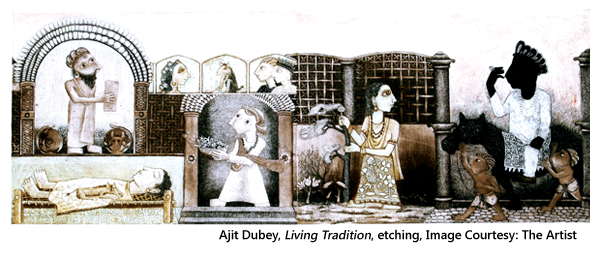
Printing came to India in 1556 (a century after Gutenberg's Bible) with the abandonment in Goa of a printing press meant for Abyssinia, and its use by Portuguese Jesuits to print and disseminate religious literature. The first woodcut illustration for a book was found in Doutrina Christiana. This book also happened to be the first in an Indian language, Tamil, and was produced in Quilon (now Kollam), Kerala.
Printmaking in the southern region as a means of artistic expression, as opposed to commercial printing, 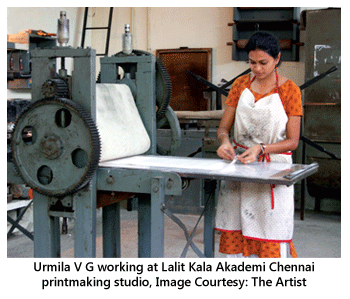 did not begin until the 1950s. It was in Tamil Nadu that K C S Paniker, the then Principal at the Government School of Art and Craft, constituted the graphics department. The engraving section of the institution was upgraded to become a full fledged graphic department offering degrees in the late 1960s. At this time, the artistic movement in Madras was centred around the Cholamandal school of thought, based at the residential artists village created near Mahabalipuram. Local craft was given large encouragement and the school also gave rise to art that was symbolic and often abstract. Consequently artists working with printmaking too were inspired by the ideologies.
did not begin until the 1950s. It was in Tamil Nadu that K C S Paniker, the then Principal at the Government School of Art and Craft, constituted the graphics department. The engraving section of the institution was upgraded to become a full fledged graphic department offering degrees in the late 1960s. At this time, the artistic movement in Madras was centred around the Cholamandal school of thought, based at the residential artists village created near Mahabalipuram. Local craft was given large encouragement and the school also gave rise to art that was symbolic and often abstract. Consequently artists working with printmaking too were inspired by the ideologies.
Several generations of artists who have passed through the institution proceeded to mark the south on the national art map. R B Bhaskaran demonstrates the movement of a southern printmaker into the larger context perfectly. Originally a painter, he studied lithography and ceramics abroad and later took over as the head of printmaking in the college. He borrowed from the symbology practiced by the Cholamandal school, added to it his personal modernity and the bold expression that his work is recognized for even today. Bhaskaran developed a signature style, painting and printing in alternation his Cat and Couple images that remain his most popular. 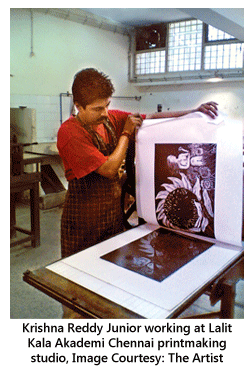 A P Paneerselvam emerged as a very confident printmaker after his experience at Garhi Studios Delhi and Hayter's Atelier 17 under Krishna Reddy in Paris, while S Dakshinamurthy combined his print work with experimentation in sculpture. Thota Tharani explored the linear form in script and alphabet, both through prints and paintings, and is now one of the most sought after art directors in the southern film industry. Rm Palaniappan broke the moulds of conventional printmaking, and took the use of etching plates to exciting new levels in his series of works on space and topography. Palaniappan was instrumental in the set up of the Lalit Kala Akademi Regional Centre in Madras in 1982, which gave numerous artists the space to work and became the veritable backbone to the local printmaking movement.
A P Paneerselvam emerged as a very confident printmaker after his experience at Garhi Studios Delhi and Hayter's Atelier 17 under Krishna Reddy in Paris, while S Dakshinamurthy combined his print work with experimentation in sculpture. Thota Tharani explored the linear form in script and alphabet, both through prints and paintings, and is now one of the most sought after art directors in the southern film industry. Rm Palaniappan broke the moulds of conventional printmaking, and took the use of etching plates to exciting new levels in his series of works on space and topography. Palaniappan was instrumental in the set up of the Lalit Kala Akademi Regional Centre in Madras in 1982, which gave numerous artists the space to work and became the veritable backbone to the local printmaking movement.
The next two decades saw many artists working with prints along with other media: Vasudha Thozhur, Karunamoorthy, Bhavanishankar, P Mohan, Hariraam V, Dimpy Menon, R Bala to name only a few. R Bala has spent many years on experimental printmaking, redefining the printing surface with other materials and approaching the process scientifically. A Balasubramaniam, another alumnus of Govt College of Arts and Crafts, created an artistic stir with his hologram silk screens and his later work with space and material that took elements of printmaking into an exaggerated three-dimensional scale. Asma Menon has dedicated twenty years to making etchings, portraying a mix of organic nature and feminine humanity. There are many in the present generation of artists who are actively experimenting with new forms of printmaking including Jacob Jebaraj, Manjula Padmanabhan and Gayathri Aditya.
Despite the compartmentalized approach in Indian art education, institutions have played a large role in the making of artists who have contributed to contemporary Indian visual culture, in printmaking and otherwise. In a theoretical-methodology that is only now being questioned, art institutions in India have been the yardstick to categorise artists and interpret movements and styles in art. In the South, the institutions that encouraged printmaking were the Government College of Arts and Crafts in Chennai, College of Art in Goa, Karnataka Chitrakala Parishath in Bangalore, Chamarajendra Academy of Visual Arts in Mysore, 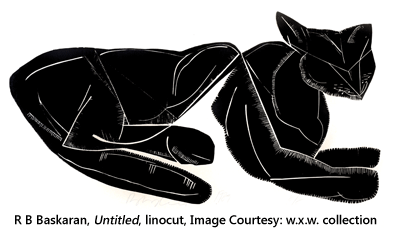 Sarojini Naidu School of Fine Arts in Hyderabad, the Department of Fine Arts, Andhra University, in Vishakhapatnam and the College of Fine Arts in Trivandrum, Kerala. Most of these art institutions adopted their own particular brand of aesthetics and styles that developed from larger cultural sensibilities, local history as well as signature styles of professors with long association with each institute. Barring the Government College of Arts and Crafts in Madras that had begun a printmaking department in the early sixties, the rest established graphic departments in the late 70's and early 80's. Most artists in the South seeking to experiment with printmaking during earlier years either went to Santiniketan in West Bengal, Maharaja Sayajirao University in Baroda, or Delhi College of Fine Art. This gave artists a chance to learn from a first generation of experimental printmakers such as B C Sanyal (b.1901), Somnath Hore (b.1921), Jyothi Bhatt (b.1934), K G Subramaniam (b.1924) and Sanat Kar (b.1934). First generation printmakers from the south returned to their home towns to teach and train others, while others remained in the larger northern universities to teach.
Sarojini Naidu School of Fine Arts in Hyderabad, the Department of Fine Arts, Andhra University, in Vishakhapatnam and the College of Fine Arts in Trivandrum, Kerala. Most of these art institutions adopted their own particular brand of aesthetics and styles that developed from larger cultural sensibilities, local history as well as signature styles of professors with long association with each institute. Barring the Government College of Arts and Crafts in Madras that had begun a printmaking department in the early sixties, the rest established graphic departments in the late 70's and early 80's. Most artists in the South seeking to experiment with printmaking during earlier years either went to Santiniketan in West Bengal, Maharaja Sayajirao University in Baroda, or Delhi College of Fine Art. This gave artists a chance to learn from a first generation of experimental printmakers such as B C Sanyal (b.1901), Somnath Hore (b.1921), Jyothi Bhatt (b.1934), K G Subramaniam (b.1924) and Sanat Kar (b.1934). First generation printmakers from the south returned to their home towns to teach and train others, while others remained in the larger northern universities to teach.
Andhra Pradesh has produced another school of printmaking, centered in Hyderabad and Vishakapatnam. The Hyderabad school of printmaking, as it might be termed, is recognized for its largely figurative content, and dedication to flawless technique and high standards defined by some of the masters in the field. Krishna Reddy came from Andhra Pradesh, studied sculpture in Santiniketan, experimented in London, Italy, and Paris, and finally settled in the US. His longing to treat the printmaking medium like a sculptural surface led him to discover the viscosity method in the 50s along with his colleagues at Atelier 17 which was run by S W Hayter in Paris. 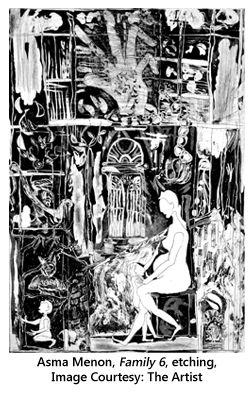 Reddy's work stood out as much for its bold abstraction as its unusual technique, and continues to inspire artists. Laxma Goud embraced printmaking as he would any other medium, carried away by its ability to support and create sinuous line, a perfect language for sensuous expression. Goud guided several generations of printmakers in etching as a teacher at the Sarojini Naidu School of Fine Art, Hyderabad. One of Laxma's contemporaries, Devraj Dakoji moved to Delhi to work at the Garhi studios and later set up the Atelier 2221, along with his wife and fellow artist Pratibha, as an effort to promote and create awareness about printmaking. D L N Reddy (b. 1949) from the beginning moved smoothly between printmaking and painting; P S Chander Sheker (b.1940) took to printmaking in the middle of his career, attracted by lithography's capacity to visualize his raw social commentary. Chippa Sudhakar (b.1965), Fawad Tamkanat (b.1962), Padma Reddy (b.1964), and Nandini Goud (b.1967) worked in the 90s, and continue today, each reflecting elements of Hyderabad as a changing metropolis, and giving printmaking its due while experimenting with other media. Krishna Reddy (junior) is one among the present generation who makes prints conventionally, also taking on the production of editions for other artists. Several artists from Vishakhapatnam including Kodanda Rao and Subhakar Tadi are trying their best to combat the un-receptivity of the market in their hometown by continuing to print in Baroda.
Reddy's work stood out as much for its bold abstraction as its unusual technique, and continues to inspire artists. Laxma Goud embraced printmaking as he would any other medium, carried away by its ability to support and create sinuous line, a perfect language for sensuous expression. Goud guided several generations of printmakers in etching as a teacher at the Sarojini Naidu School of Fine Art, Hyderabad. One of Laxma's contemporaries, Devraj Dakoji moved to Delhi to work at the Garhi studios and later set up the Atelier 2221, along with his wife and fellow artist Pratibha, as an effort to promote and create awareness about printmaking. D L N Reddy (b. 1949) from the beginning moved smoothly between printmaking and painting; P S Chander Sheker (b.1940) took to printmaking in the middle of his career, attracted by lithography's capacity to visualize his raw social commentary. Chippa Sudhakar (b.1965), Fawad Tamkanat (b.1962), Padma Reddy (b.1964), and Nandini Goud (b.1967) worked in the 90s, and continue today, each reflecting elements of Hyderabad as a changing metropolis, and giving printmaking its due while experimenting with other media. Krishna Reddy (junior) is one among the present generation who makes prints conventionally, also taking on the production of editions for other artists. Several artists from Vishakhapatnam including Kodanda Rao and Subhakar Tadi are trying their best to combat the un-receptivity of the market in their hometown by continuing to print in Baroda.
The Karnataka Chitrakala Parishath printmaking department in Bangalore is over twenty years old, and has been headed by Baroda-trained Ajit Dubey for as many years. A printmaker/painter exploring myth and folklore, Dubey has now set up a personal studio with an etching press. Karnataka born Vijay Bagodi (b.1961) is another artist whose paintings and prints veer towards myth, legend and memory. He has been an instructor in printmaking at M S University Baroda where he studied, along with Jaykumar, also from Karnataka. Sridhar Murthy and Srinivas Acharya, both teachers in the graphic department at the Chitrakala Parishath, use sensibilities garnered from printmaking within their paintings. Basavaraj Musavalgi heads the printmaking department in CAVA, Mysore, the institution that has trained artists like Ravi Kumar Kashi, Venugopal V G and Champa Mohan. Kashi uses components of printmaking in his present multi-media works, seen particularly in his paper pulp reliefs and his exploration of multiples and editions, including photography. Champa is one of the few who has chosen woodcut printing, drawing from womanly worldviews and religious mythology for content. The Ken School of Art, begun in the early 70's by artist and professor R M Hadapad, has produced noted printmakers like Chandranath Acharya who also achieved a successful career in journalistic illustration, and Sham Sunder who combines experimentation with a wide range of media with teaching at an art institute at Hyderabad. R Raja and Vaidehi Raja, both trained printmakers, together run workshops for children in printmaking.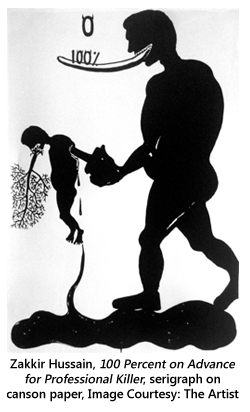 Bombay-based Archana Hande has exchanged elaborate processes of printmaking for common forms of multiple commercial printing, and other forms of public accessibility like the internet. A new media artist, her works deal with aspects of femininity and social activism. Bangalore's metamorphosizing art industry is also the creative ground for artists like Md Rizwan, Satish Sholapur, Harisha Achar, Sharath Kulagatti and Sunil Mamadapur who alternate between painting and printmaking. Bangalore is only recently developing a united artistic identity, with the movement for the present being towards experimental arts and alternative media.
Bombay-based Archana Hande has exchanged elaborate processes of printmaking for common forms of multiple commercial printing, and other forms of public accessibility like the internet. A new media artist, her works deal with aspects of femininity and social activism. Bangalore's metamorphosizing art industry is also the creative ground for artists like Md Rizwan, Satish Sholapur, Harisha Achar, Sharath Kulagatti and Sunil Mamadapur who alternate between painting and printmaking. Bangalore is only recently developing a united artistic identity, with the movement for the present being towards experimental arts and alternative media.
The Thiruvananthapuram College of Fine Art under Kerala University gives the option of printmaking as a subsidiary section to the main departments of painting, sculpture and applied art. Many art students travel to Baroda, Santiniketan, or Bangalore, to be part of a more multicultural atmosphere. Keralite Murali Cheeroth (b.1966) studied painting at Vishwa Bharati University, and took to printmaking after he received a scholarship from Kanoria Centre, Ahmedabad, where he also continued to work until recently. He is now pursuing painting and video art. Zakkir Hussain studied printmaking at M S University Baroda after a bachelor's degree in painting from Thiruvananthapuram. His work combines organic abstraction with figuration, and after a hiatus, he has now begun printmaking again. He and his artist wife Sreeja have established a personal studio for printmaking in Kochi. Ashok Kumar, whose figurative lithographs encompass human emotion and social comment, returns to his alumnus Santiniketan every time he requires printmaking apparatus. He is now working in Hosur, near Bangalore. Keralites Sunil Lal and Shyam are two young artists who are pursuing printmaking outside of their hometowns, in Santiniketan and Bangalore respectively.
Goa, perhaps due to its geographic position, is left out of the discourse of regional art histories, both in the north, and the south. The history of printing in India began here, but printmaking as a fine art course started when Professor K S Vishwambhar under the encouragement of the then principal Laxman Pai established a department at Goa College of Art in 1975. He has worked over the years with lithography, etching and woodcut, besides lending his support to printmaking departments in other universities. The department thrived, with students from all practices experimenting with prints. Hanuman Kambli experimented with etching surfaces for his drawing, and now uses graphic devices within his painting compositions too. Theodore Mariano Mesquita studied at Bombay and Baroda before joining the Goa College of art as a teacher. Primarily a figurative painter and exploring what he calls 'psychological landscapes', Theodore has developed a system of digital lithography where he uses computer software to aid his prints. Another Goan, Querozitto de Souza, studied printmaking at Santiniketan. Attracted to lithography from the beginning, Querozitto's subject matter delves into eroticism and masculinity. Rajan Fulari, working in Mumbai, owes his interest in printmaking to the medium's ability to exploit every nuance of line. In the younger generation of printmakers, Satish Shivarudriah with his minimal lithographs and etchings, and Viraj Naik with his surreal drawings and etchings are working at popularizing the printmaking practice.
That the medium will continue to live as a fine art is what we can work towards. Awareness drives by galleries and institutions; exhibitions exploring different forms of printmaking; sensitivity in teaching methodologies and removal of compartmentalization of fine art departments; stable and critical approaches in valuing art; more government supported and maintained regional printmaking centres; open debates and united approaches – these are some of the suggestions artists have made for the betterment of the medium in the South, and in general.